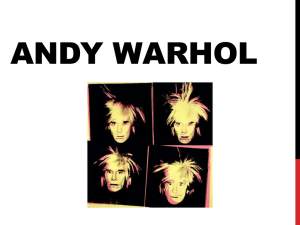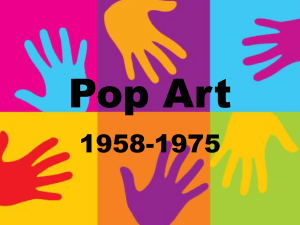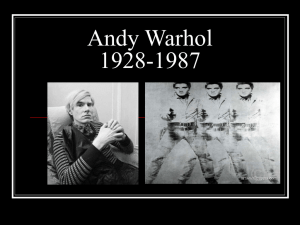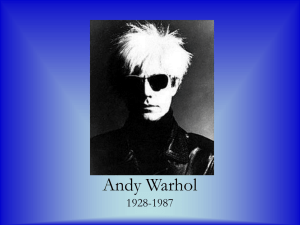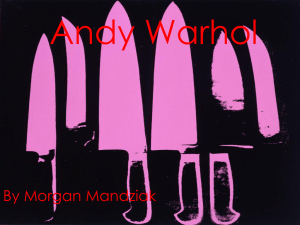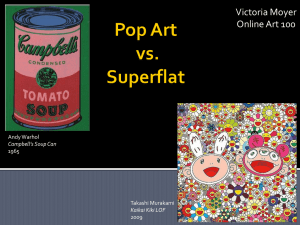Andy Warhol The youngest child of three, Andy was born Andrew
advertisement
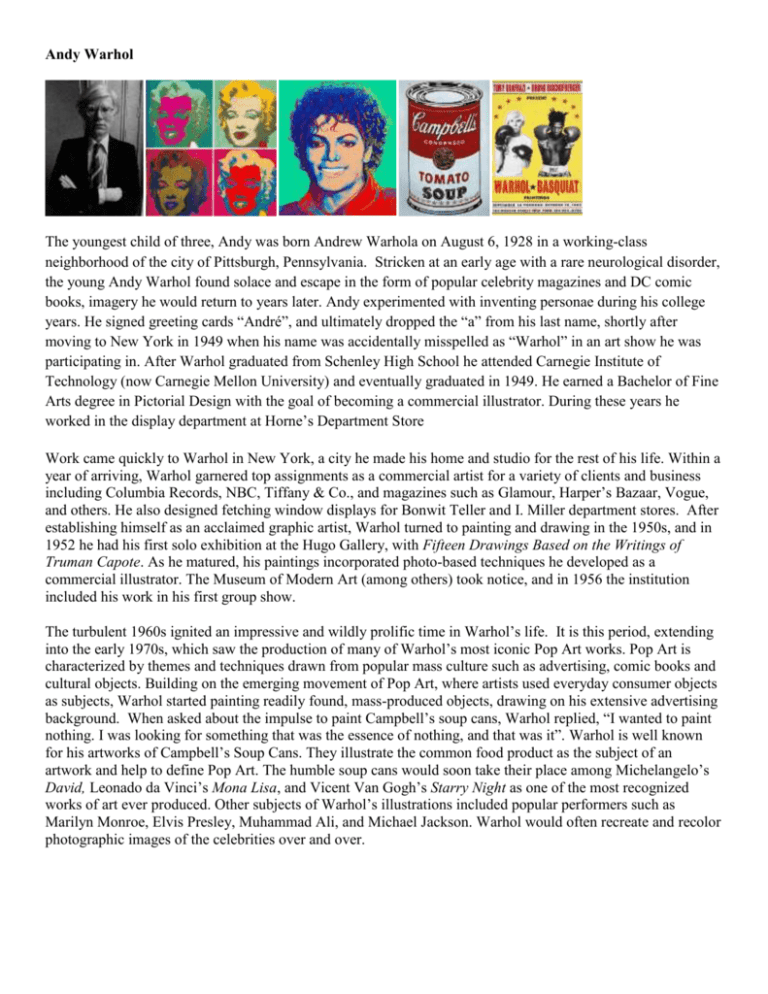
Andy Warhol The youngest child of three, Andy was born Andrew Warhola on August 6, 1928 in a working-class neighborhood of the city of Pittsburgh, Pennsylvania. Stricken at an early age with a rare neurological disorder, the young Andy Warhol found solace and escape in the form of popular celebrity magazines and DC comic books, imagery he would return to years later. Andy experimented with inventing personae during his college years. He signed greeting cards “André”, and ultimately dropped the “a” from his last name, shortly after moving to New York in 1949 when his name was accidentally misspelled as “Warhol” in an art show he was participating in. After Warhol graduated from Schenley High School he attended Carnegie Institute of Technology (now Carnegie Mellon University) and eventually graduated in 1949. He earned a Bachelor of Fine Arts degree in Pictorial Design with the goal of becoming a commercial illustrator. During these years he worked in the display department at Horne’s Department Store Work came quickly to Warhol in New York, a city he made his home and studio for the rest of his life. Within a year of arriving, Warhol garnered top assignments as a commercial artist for a variety of clients and business including Columbia Records, NBC, Tiffany & Co., and magazines such as Glamour, Harper’s Bazaar, Vogue, and others. He also designed fetching window displays for Bonwit Teller and I. Miller department stores. After establishing himself as an acclaimed graphic artist, Warhol turned to painting and drawing in the 1950s, and in 1952 he had his first solo exhibition at the Hugo Gallery, with Fifteen Drawings Based on the Writings of Truman Capote. As he matured, his paintings incorporated photo-based techniques he developed as a commercial illustrator. The Museum of Modern Art (among others) took notice, and in 1956 the institution included his work in his first group show. The turbulent 1960s ignited an impressive and wildly prolific time in Warhol’s life. It is this period, extending into the early 1970s, which saw the production of many of Warhol’s most iconic Pop Art works. Pop Art is characterized by themes and techniques drawn from popular mass culture such as advertising, comic books and cultural objects. Building on the emerging movement of Pop Art, where artists used everyday consumer objects as subjects, Warhol started painting readily found, mass-produced objects, drawing on his extensive advertising background. When asked about the impulse to paint Campbell’s soup cans, Warhol replied, “I wanted to paint nothing. I was looking for something that was the essence of nothing, and that was it”. Warhol is well known for his artworks of Campbell’s Soup Cans. They illustrate the common food product as the subject of an artwork and help to define Pop Art. The humble soup cans would soon take their place among Michelangelo’s David, Leonado da Vinci’s Mona Lisa, and Vicent Van Gogh’s Starry Night as one of the most recognized works of art ever produced. Other subjects of Warhol’s illustrations included popular performers such as Marilyn Monroe, Elvis Presley, Muhammad Ali, and Michael Jackson. Warhol would often recreate and recolor photographic images of the celebrities over and over. “Being good in business is the most fascinating kind of art. Making money is art and working is art and good business is the best art.” -Andy Warhol “In the future, everyone will be famous for 15 minutes.” -Andy Warhol “I like boring things.” -Andy Warhol Operating out of a silver-painted, and foil-draped studio nicknamed The Factory, located at 231 East 47th Street, (his second studio space to hold that title), Warhol embraced work in film and video. He made his first films with a newly purchased Bolex camera in 1963 and began experimenting with video as early as 1965. Now considered avant-garde cinema classics, Warhol’s early films include Sleep (1963), Empire (1963), and Kiss (1963-64). With sold out screenings in New York, Los Angeles, and Cannes, the split-screen, pseudodocumentary Chelsea Girls (1966) brought new attention to Warhol from the film world. Art critic David Bourdon wrote, “word around town was underground cinema had finally found its Sound of Music in Chelsea Girls.” Warhol would make nearly 600 films and nearly 2500 videos. Among these are the 500, 4-minute films that comprise Warhol’s Screen Tests, which feature unflinching portraits of friends, associates and visitors to the Factory, all deemed by Warhol to be in possession of “star quality”. In 1968 Warhol suffered a nearly fatal gun-shot wound from aspiring playwright and radical feminist author, Valerie Solanas. The shooting, which occurred in the entrance of the Factory, forever changed Warhol. Some point to the shock of this event as a factor in his further embrace of an increasingly distant persona. The brush with death along with mounting pressure from the Internal Revenue Service (stemming from his critical stance against President Richard Nixon), seem to have prompted Warhol to document his life to an ever more obsessive degree. He would dictate every activity, including noting the most minor expenses, and employ interns and assistants to transcribe the content of what would amount to over 3,400 audio tapes. Portions of these accounts were published posthumously in 1987 as The Warhol Diaries. The traumatic attempt on his life did not, however, slow down his output or his cunning ability to seamlessly infiltrate the worlds of fashion, music, media, and celebrity. His artistic practice soon intersected with all aspects of popular culture, in some cases long before it would become truly popular. He co-founded Interview Magazine; appeared on television in a memorable episode of The Love Boat; painted an early computer portrait of singer Debbie Harry; designed Grammy-winning record covers for The Rolling Stones; signed with a modeling agency; contributed short films to Saturday Night Live; and produced Andy Warhol’s Fifteen Minutes and Andy Warhol’s TV, his own television programs for MTV and cable access. He also developed a strong business in commissioned portraits, becoming highly sought after for his brilliantly-colored paintings of politicians, entertainers, sports figures, writers, debutantes and heads of state. His paintings, prints, photographs and drawings of this time include the important series, Skulls, Guns, Camouflage, Mao, and The Last Supper. While in Milan, attending the opening of the exhibition of The Last Supper paintings, Warhol complained of severe pain in his right side. After delaying a hospital visit, he was eventually convinced by his doctors to check into New York Hospital for gall bladder surgery. On February 22, 1987, while in recovery from this routine operation, Andy Warhol died. According to news reports, he had been making good recovery from surgery at New York Hospital before dying in his sleep from a sudden heart attack. The hospital staff had failed to adequately monitor his condition and overloaded him with fluids after his operation, causing him to suffer from a fatal case of water intoxication, which prompted Warhol's lawyers to sue the hospital for negligence. Prior to his diagnosis and operation, Warhol delayed having his recurring gallbladder problems checked, as he was afraid to enter hospitals and see doctors. Following burial in Pittsburgh, thousands of mourners paid their respects at a memorial service held at Manhattan’s St. Patrick’s Cathedral. The service was attended by numerous associates and admirers including artists Roy Lichtenstein, Keith Haring, and entertainer Liza Minnelli. Readings were contributed by Yoko Ono and Factory collaborator and close friend, Brigid Berlin. Warhol was a prolific artist, producing numerous works through the 1970s and 1980s. More than twenty years after his death, Andy Warhol remains one of the most influential figures in contemporary art and culture. Warhol’s life and work inspires creative minds worldwide thanks to his enduring imagery, his artfully cultivated celebrity, and the ongoing research of dedicated scholars. His impact as an artist is far deeper and greater than his one prescient observation that “everyone will be world famous for fifteen minutes.” His curiosity resulted in an enormous body of work that spanned every available medium and contributed to the collapse of boundaries between high and low culture. Plans to house The Andy Warhol Museum in Pittsburgh were announced in 1989, two years after the establishment of the Andy Warhol Foundation for the Visual Arts. Through the ongoing efforts of both of these institutions, Andy Warhol remains not only a fascinating cultural icon, but an inspiration to new generations of artists, curators, filmmakers, designers, and cultural innovators the world over.
